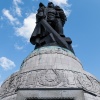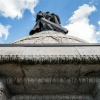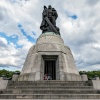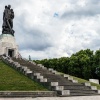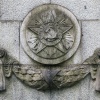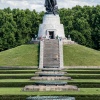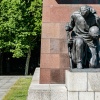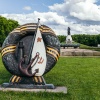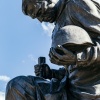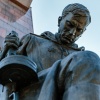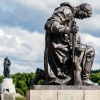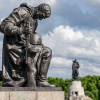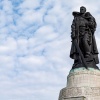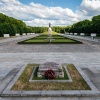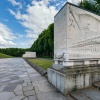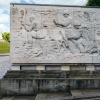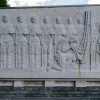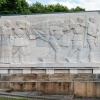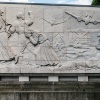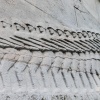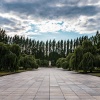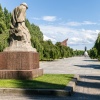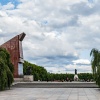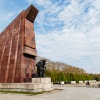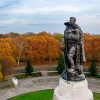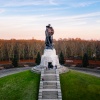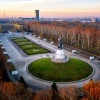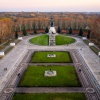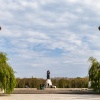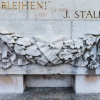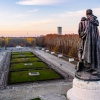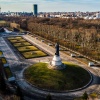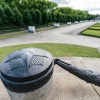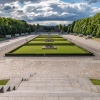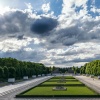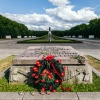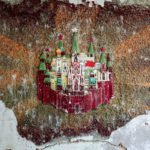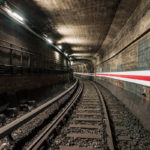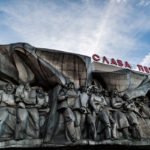East Germany’s Soviet Heritage – The Treptow War Memorial in Berlin
As a small boy I was pretty much impressed by the Soviet War Memorial being located in Berlin’s Treptower Park and even today that place has quite some impact. However, nowadays such a visit is generally voluntary than back in the days, as the whole school had got to show up there. Though, that wasn’t a loss as independent from the system one’s living in one could get a feeling for what history means, war stands for and what has to be prevented from happening again. The memorial site lies a bit hidden behind the trees of Treptower Park and only the granite triumphal arches give a hint what can be seen when going further. The war memorial played an important role when the Group of Soviet Forces in Germany (GSFG) backed out on June 25th 19 years ago.
While most of the troops left East Germany through the Soviet hig command in Wünsdorf, some soldiers stayed for the central farewell celebration that happened at the Treptow war memorial. Ein kleines Video davon ist auf YouTube verfügbar.
My visit of the memorial site had a “nice” start when a grumpy ol man tried to enlighten my narrow mind how evil the Soviets were. Funnily he never had contact with them and his choice of words reminded of Nazi jargon, why his wife backed out like the Russian troops like “he’s not belonging to me”.
The Soviets opened the site on the 4th anniversary of the victory over Hitler, the final surrender of Germany, hence in a period when Stalin monumentalism, like for example Warsaw’s Palace of Culture and Science, had its biggest architecture-wise prosperity. With 10 hectares in expanse the war memorial is pretty large, but that’s no surprise as it also accommodates 7.000 war graves.
After having entered the memorial through the granite triumphal arch on Puschinallee street, you immediately spot the site’s central element, the statue “The Liberator” built by Yevgeny Vuchetich. It shows Soviet soldier holding a longsword in his one and a young child with his other hand. The statue stands on a shattered swastika (Hakenkreuz).
The memorial’s major axis is framed by 16 marble stone sarcophagi. Its reliefs are telling the story of World War II in reliefs. The last two sarcophagi are special though as they stand in alignment with the main statue and are dedicated to the “heroic dying” of the Russain people.
Well, it is pretty much disturbing to see generations McDonalds & Hipster as well as new wanna-be Berliners jumping around half naked all over the premises like a six-year-old. Something’s just missing in their coordinate system when it comes to social competences.
Even more disturbing is to witness others’ stupidity in terms of history as soon as they open their mouth. What brings us back to the grumpy guy in the beginning and the importance of what history story had been told at school…
Berlin police patrols the memorial site. However those untrained appearing officers, sitting in their warm car, do not really make it to protect the memorial site from graffiti and smearing, alcohol consumption, annoying cyclists or from locals emptying their mutts in the premises’ vegetation. Real rememberance, as written at the entrance, looks different and that’s something most Berliners only have a big mouth about it instead of letting deeds talk.
My photo series “East Germany’s Soviet Heritage” reflects my interest for history. Germany and Russia are nowadays as well as back in the days tighly connected and experienced moment of glory as well as agony. That’s exactly what this photo series shall reflect, not at evaluation, not as propaganda, but as a document and intellectual approach.
This photo documtation was shot together with photographer friend Torsten Goltz.
More on WikiPedia: http://en.wikipedia.org/wiki/Soviet_War_Memorial_(Treptower_Park)
